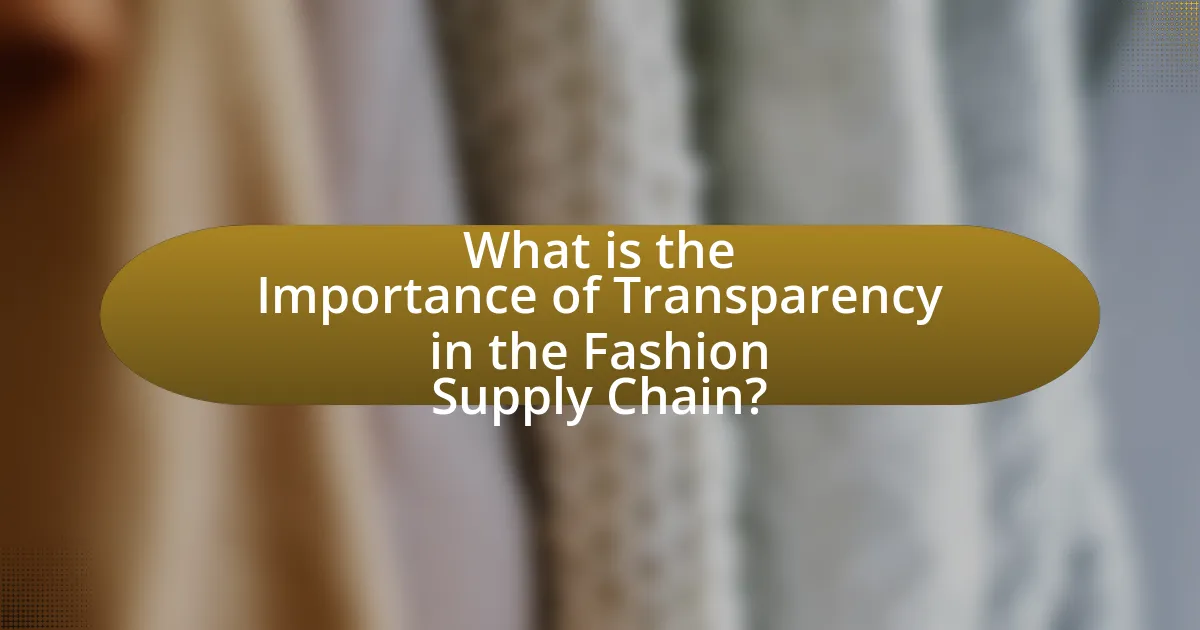Transparency in the fashion supply chain is essential for building trust and accountability among consumers and brands. It allows consumers to make informed decisions regarding the ethical and environmental implications of their purchases, with a significant majority expressing a desire to know the origins of their clothing. Key elements of transparency include visibility, traceability, and accountability, which collectively enhance brand reputation and consumer loyalty. However, challenges such as complex sourcing networks and lack of standardized data hinder transparency efforts. The article explores the benefits of transparency for stakeholders, the financial advantages for brands, and best practices for achieving transparency, highlighting successful examples and the role of consumer advocacy in driving change within the industry.

What is the Importance of Transparency in the Fashion Supply Chain?
Transparency in the fashion supply chain is crucial for fostering trust and accountability among stakeholders. It enables consumers to make informed choices about the ethical and environmental impact of their purchases. For instance, a 2021 report by Fashion Revolution revealed that 79% of consumers want to know where their clothes come from, highlighting the demand for transparency. Furthermore, transparency helps brands identify and mitigate risks related to labor practices and environmental sustainability, ultimately leading to improved brand reputation and customer loyalty.
Why is transparency crucial in the fashion industry?
Transparency is crucial in the fashion industry because it fosters accountability and builds consumer trust. When brands openly share information about their supply chains, including labor practices and environmental impact, consumers can make informed choices that align with their values. For instance, a 2021 report by Fashion Revolution revealed that 79% of consumers want to know where their clothes come from, highlighting the demand for transparency. This openness not only encourages ethical practices among manufacturers but also drives brands to improve sustainability efforts, ultimately benefiting both society and the environment.
What are the key elements of transparency in the supply chain?
The key elements of transparency in the supply chain include visibility, traceability, and accountability. Visibility refers to the ability to see and understand the flow of goods and information throughout the supply chain, enabling stakeholders to monitor processes and identify inefficiencies. Traceability allows for tracking the origin and journey of products, ensuring that consumers can verify the ethical and sustainable practices of suppliers. Accountability involves holding all parties responsible for their actions and decisions, fostering trust among consumers and partners. These elements collectively enhance the integrity of the supply chain, as evidenced by studies showing that companies with transparent practices experience increased consumer trust and loyalty.
How does transparency impact consumer trust?
Transparency significantly enhances consumer trust by providing clear and accessible information about products and practices. When brands openly share details regarding their sourcing, manufacturing processes, and labor conditions, consumers feel more informed and empowered to make ethical purchasing decisions. A study by Label Insight found that 94% of consumers are more likely to be loyal to a brand that offers complete transparency. This indicates that transparency not only fosters trust but also drives consumer loyalty, as customers are increasingly seeking brands that align with their values and ethical standards.
What challenges does the fashion supply chain face regarding transparency?
The fashion supply chain faces significant challenges regarding transparency, primarily due to complex sourcing networks and lack of standardized data. The intricate web of suppliers, manufacturers, and logistics providers often obscures the origins of materials and labor practices, making it difficult for brands to ensure ethical compliance. According to a 2021 report by the Fashion Transparency Index, only 40% of major fashion brands disclose their suppliers, highlighting the pervasive issue of information opacity. Additionally, varying regulations across countries further complicate transparency efforts, as brands may not be held to the same standards globally. This lack of clarity not only undermines consumer trust but also hinders the industry’s ability to address sustainability and ethical concerns effectively.
What are the common barriers to achieving transparency?
Common barriers to achieving transparency in the fashion supply chain include lack of standardized data, resistance from stakeholders, and complex supply chain structures. The absence of standardized data makes it difficult to compare and verify information across different entities, leading to inconsistencies. Resistance from stakeholders, such as manufacturers and suppliers, often stems from fears of exposing unethical practices or competitive disadvantages. Additionally, the complexity of supply chains, which can involve multiple tiers of suppliers and subcontractors, complicates efforts to trace materials and labor practices effectively. These barriers hinder the ability to provide clear and accurate information about sourcing, production processes, and labor conditions.
How do ethical concerns influence transparency in fashion?
Ethical concerns significantly influence transparency in fashion by driving brands to disclose their supply chain practices and labor conditions. As consumers increasingly demand accountability regarding environmental sustainability and fair labor practices, fashion companies are compelled to provide clear information about their sourcing, production processes, and the treatment of workers. For instance, a 2021 report by Fashion Revolution found that 60% of consumers want to know where their clothes come from, highlighting the growing expectation for brands to be transparent. This shift towards transparency not only enhances brand reputation but also fosters consumer trust, ultimately leading to more ethical business practices within the industry.

How does transparency benefit stakeholders in the fashion supply chain?
Transparency benefits stakeholders in the fashion supply chain by fostering trust, enhancing accountability, and promoting ethical practices. When brands disclose information about sourcing, labor conditions, and environmental impact, consumers can make informed choices, leading to increased loyalty and sales. Additionally, suppliers and manufacturers are encouraged to adhere to ethical standards, reducing risks of exploitation and improving working conditions. Research from the Fashion Transparency Index indicates that brands with higher transparency scores often experience better reputational outcomes and consumer engagement, demonstrating the tangible advantages of transparency for all stakeholders involved.
What advantages does transparency provide to consumers?
Transparency provides consumers with the advantage of informed decision-making. When consumers have access to clear information about product origins, manufacturing processes, and labor practices, they can make choices that align with their values, such as ethical consumption and sustainability. Research indicates that 66% of consumers are willing to pay more for sustainable brands, highlighting the demand for transparency in the fashion supply chain. This access to information fosters trust between consumers and brands, leading to increased customer loyalty and satisfaction.
How does transparency enhance consumer decision-making?
Transparency enhances consumer decision-making by providing clear and accessible information about products, enabling consumers to make informed choices. When consumers understand the sourcing, production processes, and ethical implications of their purchases, they can align their buying decisions with their values, such as sustainability and fair labor practices. Research indicates that 66% of consumers are willing to pay more for sustainable brands, highlighting the impact of transparency on purchasing behavior. Furthermore, transparency builds trust between brands and consumers, as evidenced by a 2020 study from the Harvard Business Review, which found that companies with transparent practices experience higher customer loyalty and satisfaction.
What role does transparency play in promoting sustainable practices?
Transparency plays a crucial role in promoting sustainable practices by enabling stakeholders to access information about environmental and social impacts within supply chains. When companies disclose their sourcing, production methods, and labor practices, it fosters accountability and encourages responsible behavior among suppliers. Research indicates that brands with transparent practices are more likely to adopt sustainable initiatives, as consumers increasingly demand ethical standards. For instance, a 2020 study by McKinsey & Company found that 66% of consumers are willing to pay more for sustainable brands, highlighting the market incentive for transparency. This openness not only builds consumer trust but also drives industry-wide improvements in sustainability.
How does transparency affect brands and manufacturers?
Transparency significantly impacts brands and manufacturers by enhancing consumer trust and loyalty. When brands openly share information about their supply chains, production processes, and sourcing practices, they foster a sense of accountability and integrity. Research indicates that 73% of consumers are willing to pay more for sustainable products, highlighting the importance of transparency in influencing purchasing decisions. Furthermore, brands that prioritize transparency can differentiate themselves in a competitive market, as consumers increasingly demand ethical practices. This shift is supported by a 2021 survey from McKinsey, which found that 67% of consumers consider sustainability when making purchasing choices, underscoring the direct correlation between transparency and brand reputation.
What are the financial benefits of being transparent?
Being transparent in the fashion supply chain leads to significant financial benefits, including increased consumer trust and loyalty, which can drive higher sales. Research indicates that 66% of consumers are willing to pay more for sustainable brands, highlighting the financial advantage of transparency in sourcing and production practices. Additionally, transparent companies often experience reduced operational risks and costs associated with compliance and supply chain disruptions, as they foster better relationships with suppliers and stakeholders. This proactive approach can result in long-term savings and improved profitability.
How can transparency improve brand reputation?
Transparency can significantly improve brand reputation by fostering trust and loyalty among consumers. When brands openly share information about their supply chain practices, sourcing, and production processes, they demonstrate accountability and ethical standards. A study by Label Insight found that 94% of consumers are more likely to be loyal to a brand that offers complete transparency. This trust leads to positive word-of-mouth, increased customer retention, and ultimately, a stronger brand image in a competitive market.

What are the best practices for achieving transparency in the fashion supply chain?
The best practices for achieving transparency in the fashion supply chain include implementing traceability systems, engaging in open communication with stakeholders, and adopting sustainable sourcing practices. Traceability systems, such as blockchain technology, allow brands to track the origin and journey of materials, ensuring accountability at each stage. Open communication fosters trust and collaboration among suppliers, manufacturers, and consumers, enabling brands to share information about labor practices and environmental impact. Sustainable sourcing practices, including the use of certified materials and ethical labor standards, further enhance transparency by demonstrating a commitment to responsible production. These practices are supported by industry reports, such as the Fashion Transparency Index, which evaluates brands on their disclosure of supply chain information, highlighting the growing demand for accountability in the fashion industry.
What strategies can brands implement to enhance transparency?
Brands can enhance transparency by implementing supply chain traceability systems. These systems allow brands to track and disclose the origins of their materials, production processes, and labor practices. For instance, using blockchain technology can provide immutable records of each step in the supply chain, ensuring that consumers have access to verified information about product sourcing and manufacturing. A study by the World Economic Forum highlights that 70% of consumers are more likely to purchase from brands that provide clear information about their supply chains. By adopting such strategies, brands not only build consumer trust but also comply with increasing regulatory demands for transparency in the fashion industry.
How can technology facilitate transparency in the supply chain?
Technology facilitates transparency in the supply chain by enabling real-time tracking and data sharing among all stakeholders. For instance, blockchain technology allows for immutable records of transactions, ensuring that every step of the supply chain is documented and accessible. According to a report by the World Economic Forum, implementing blockchain can reduce supply chain costs by up to 20% while increasing transparency and trust among participants. Additionally, Internet of Things (IoT) devices provide continuous monitoring of goods, allowing companies to track conditions and locations, which enhances accountability and reduces the risk of fraud. These technological advancements collectively contribute to a more transparent and efficient supply chain in the fashion industry.
What role do certifications and standards play in promoting transparency?
Certifications and standards play a crucial role in promoting transparency by establishing clear benchmarks for ethical practices and sustainability within the fashion supply chain. These certifications, such as Fair Trade and Global Organic Textile Standard, provide consumers with verifiable information about the sourcing, production, and labor conditions of products. For instance, a study by the Textile Exchange found that certified organic cotton production increased transparency by ensuring that farmers adhere to specific environmental and social criteria, thereby allowing consumers to make informed choices. This structured approach not only enhances consumer trust but also encourages brands to maintain accountability in their operations, ultimately fostering a more transparent industry.
What are some successful examples of transparency in the fashion industry?
Successful examples of transparency in the fashion industry include brands like Everlane, Patagonia, and Reformation. Everlane is known for its “Radical Transparency” model, where it openly shares the true costs behind its products, including materials, labor, and transportation, allowing consumers to understand pricing. Patagonia emphasizes environmental and social responsibility by providing detailed information about its supply chain and sourcing practices, including the use of recycled materials and fair labor conditions. Reformation showcases its sustainability efforts through a “RefScale” that quantifies the environmental impact of its products, making this information accessible to consumers. These brands demonstrate that transparency can enhance consumer trust and promote ethical practices in the fashion industry.
Which brands are leading the way in supply chain transparency?
Patagonia, Everlane, and Uniqlo are leading the way in supply chain transparency. Patagonia is known for its commitment to environmental sustainability and provides detailed information about its sourcing and manufacturing processes. Everlane emphasizes “radical transparency,” sharing costs and factory details with consumers. Uniqlo has made strides in transparency by publishing a list of its suppliers and engaging in initiatives to improve labor conditions. These brands exemplify transparency by openly communicating their practices and supply chain information to consumers.
What lessons can be learned from these examples?
The lessons learned from examples of transparency in the fashion supply chain include the necessity for accountability, the enhancement of consumer trust, and the promotion of ethical practices. Accountability is crucial as brands that disclose their sourcing and production processes are held responsible for their impact on workers and the environment. For instance, companies like Patagonia have demonstrated that transparency can lead to increased customer loyalty and brand reputation. Additionally, consumer trust is significantly bolstered when brands openly share information about their supply chains, as seen with Everlane’s “Radical Transparency” model, which has attracted a dedicated customer base. Lastly, promoting ethical practices is essential; brands that prioritize transparency often adopt fair labor practices and sustainable sourcing, as evidenced by the Fashion Transparency Index, which highlights companies that are making strides in ethical supply chain management.
How can consumers advocate for transparency in the fashion supply chain?
Consumers can advocate for transparency in the fashion supply chain by demanding information about the sourcing and production processes of their clothing. This can be achieved through actions such as supporting brands that disclose their supply chain practices, participating in campaigns that promote ethical fashion, and utilizing social media to raise awareness about the importance of transparency. Research indicates that 66% of consumers are willing to pay more for sustainable brands, highlighting the market demand for transparency. By actively engaging in these practices, consumers can influence brands to adopt more transparent policies and practices.
What actions can consumers take to support transparent brands?
Consumers can support transparent brands by actively researching and choosing to purchase from companies that disclose their supply chain practices. This includes looking for brands that provide information about sourcing materials, labor conditions, and environmental impact. According to a 2021 survey by the Global Fashion Agenda, 66% of consumers expressed a preference for brands that are transparent about their sustainability efforts. By prioritizing purchases from these brands, consumers can drive demand for transparency and encourage other companies to adopt similar practices.
How can consumer awareness drive change in the industry?
Consumer awareness can drive change in the fashion industry by increasing demand for transparency and ethical practices. When consumers are informed about the environmental and social impacts of their purchases, they are more likely to support brands that prioritize sustainable and ethical supply chains. For instance, a 2021 survey by McKinsey & Company found that 67% of consumers consider sustainability when making a purchase, indicating a significant shift towards responsible consumerism. This heightened awareness compels companies to adopt more transparent practices, such as disclosing sourcing information and labor conditions, to meet consumer expectations and maintain market competitiveness.

Leave a Reply